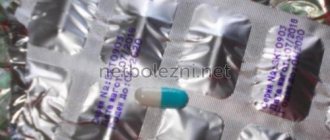Write a review
Reviews: 0
Manufacturers: Synthesis
Active ingredients
- Kanamycin
Disease class
- Bacterial meningitis, not elsewhere classified
- Blepharitis
- Conjunctivitis, unspecified
- Corneal ulcer
- Keratitis, unspecified
- Acute and subacute endocarditis
- Pneumonia without specifying the pathogen
- Abscess of the lung and mediastinum
- Pyothorax
- Peritonitis
- Liver failure, not elsewhere classified
- Cholecystitis
- Cholangitis
- Respiratory tuberculosis, confirmed bacteriologically and histologically
- Diarrhea and gastroenteritis of suspected infectious origin
- Septicemia, unspecified
- Cystitis
- Diagnosis of gastrointestinal diseases
Clinical and pharmacological group
- Antibacterial agents
Pharmacological action
- Antituberculosis
- Antibacterial
- Bactericidal
Pharmacological group
- Aminoglycosides
Pharmacological properties of the drug Kanamycin
Pharmacodynamics . Kanamycin is a broad-spectrum antibiotic. It has a bactericidal effect on most gram-positive and gram-negative microorganisms, as well as acid-fast bacteria. Acts on strains of Mycobacterium tuberculosis, including those resistant to streptomycin, PAS, and isoniazid. By binding to the 30S subunit of the ribosomal membrane, it inhibits protein synthesis in the microbial cell. Effective, as a rule, against microorganisms resistant to tetracycline, erythromycin, and chloramphenicol. Does not affect anaerobic microorganisms, yeast, viruses and most protozoa. Pharmacokinetics. When administered intramuscularly, it quickly enters the blood, the therapeutic concentration is maintained for 8–12 hours. Penetrates into the pleural cavity, synovial fluid, bronchial secretions, bile, and through the placental barrier. Normally, kanamycin does not penetrate the BBB, but with inflammation of the meninges, its concentration in the CSF reaches 30–60% of that in the blood plasma. Excreted by the kidneys within 24–48 hours.
Side effects
Nervous system disorders: ototoxicity (damage to a pair of 8 cranial nerves). with prolonged use, the development of neuritis of the auditory nerve is possible, which is manifested by noise, ringing or a feeling of congestion in the ears, and a decrease in hearing acuity. These symptoms may be irreversible. the perception of high frequencies is initially impaired (detected by audiometry); irreversible impairment of speech recognition, noticeable to the patient, is added later.
Damage to the vestibular apparatus is manifested by dizziness or vertigo, impaired coordination of movements. With symmetrical damage to the vestibular apparatus, these disorders may not be noticeable in the first stages. Cases of irreversible ototoxicity have been reported.
Neurotoxicity (encephalopathy, confusion, lethargy, hallucinations, depression). Peripheral neuropathy.
Neuromuscular blockade is also possible, manifested by respiratory depression due to paralysis of the respiratory muscles, headache, general weakness, drowsiness, muscle twitching, paresthesia, convulsions.
From the urinary system: nephrotoxicity. Kidney damage, manifested by reversible renal failure, usually mild, rarely - acute tubular necrosis, interstitial nephritis, decreased glomerular filtration rate (observed after several days of treatment or after cessation of therapy), increased levels of creatinine in the blood plasma, microhematuria, albuminuria, cylindruria.
In addition to high concentrations of the drug in the blood plasma, which especially increases the risk of developing ototoxicity and nephrotoxicity, there are many other risk factors (see SPECIAL INSTRUCTIONS).
Electrolyte imbalance: hypomagnesemia, hypocalcemia, hypokalemia.
Gastrointestinal disorders: nausea, vomiting, diarrhea, dysbacteriosis.
From the cardiovascular system: arterial hypotension.
From the skin and mucous membrane: stomatitis.
Allergic reactions: rarely - rash, itching, swelling, skin hyperemia. In isolated cases, anaphylactoid reactions may occur.
Changes at the injection site: Irritation and pain at the injection site may occur. Also possible: hyperemia, bruising, hematoma, compaction, atrophy or necrosis of the subcutaneous tissue.
From the blood coagulation system: purpura.
Laboratory indicators: increased levels of plasma aminotransferases, increased bilirubin levels. Changes in the blood (anemia, leukopenia, granulocytopenia, thrombocytopenia).
Use of the drug Kanamycin
Kanamycin is prescribed only intramuscularly. Before prescribing the drug, in the absence of contraindications, it is necessary to conduct a skin test for tolerability. For children under 1 year of age with infections of non-tuberculous etiology (in exceptional cases), the drug is prescribed in an average daily dose of 0.1 g; at the age of 1–5 years – 0.1–0.3 g; over 5 years - 0.3–0.5 g; maximum daily dose - 15 mg/kg; frequency of administration - 2-3 times a day. The duration of treatment is 5–7 days. For adults, a single dose for the treatment of infections of non-tuberculous etiology is 0.5 g every 8–12 hours, the daily dose is 1–1.5 g; maximum single dose - 1 g with an interval between administrations of 12 hours; the maximum daily dose is 2 g. Duration of treatment is 5–7 days. For the treatment of tuberculosis, adults are prescribed 1 g 1 time per day, children - 15 mg/kg 1 time per day. Treatment lasts ≥1 month (the drug is administered in cycles: daily for 6 days, on the 7th day - a break). A solution for intramuscular administration is prepared ex tempore by adding 4 ml of sterile water for injection or 0.25–0.5% procaine solution to the contents of the bottle (1 g), injected deep into the upper outer quadrant of the buttock 2–3 once a day.
special instructions
The basis for the use of kanamycin is the ineffectiveness of other antibiotics. when the pathogen is insensitive to drugs of the neomycin group (gentamicin, neomycin), cross-resistance to kanamycin is usually observed.
Risk factors for the development of ototoxicity and/or nephrotoxicity of the drug are: genetically determined susceptibility to ototoxic action (one should find out if there are cases of ototoxicity of aminoglycosides in relatives); elderly age; initial hearing impairment (otitis media, meningitis, birth trauma, hypoxia during childbirth); high doses, long course of treatment; simultaneous use of other ototoxic and nephrotoxic drugs (see INTERACTIONS); diseases of the kidneys and cardiovascular system, leading to the accumulation of the drug; dehydration; diabetes; HIV infection; renal failure.
In this regard, before starting therapy, as well as during treatment with the drug, it is necessary to:
- careful monitoring of renal function (repeated urine tests, determination of plasma creatinine and calculation of glomerular filtration every 3 days, if this indicator decreases by 50%, the drug should be discontinued);
- examination of auditory function (audiometry at least 2 times a week);
- monitoring the concentration of kanamycin in the blood. At the first signs of ototoxicity (even minor tinnitus) or nephrotoxicity, kanamycin is discontinued.
If there are imbalances, the interval between injections must be increased.
The possibility of neuromuscular blockade should be taken into account (the injection must be carried out in the presence of all the necessary conditions for mechanical ventilation). The risk of developing severe neuromuscular blockade when using the drug increases in patients with parkinsonism, myasthenia gravis, botulism, and when kanamycin is used simultaneously with muscle relaxants. To relieve the manifestations of neuromuscular blockade, intravenous calcium chloride or anticholinesterase drugs are used.
If signs of respiratory depression appear, it is necessary to stop the administration of kanamycin and urgently administer an intravenous solution of calcium chloride and a subcutaneous solution of proserine with atropine. If necessary, the patient is transferred to controlled breathing.
When potassium levels decrease, it is necessary to monitor the content of magnesium and calcium in the blood plasma.
In elderly people, kanamycin should be prescribed only if it is impossible to use less toxic antibiotics.
Slower metabolism of the drug in elderly patients leads to longer circulation in the blood even with normal renal function, which leads to an increased risk of ototoxic manifestations in this category of patients.
When using the drug, do not exceed the recommended dose.
Patients with impaired liver function. In patients with liver pathology, the level of the drug in the blood does not change (except for severe alcoholic cirrhosis with ascites, leading to a larger volume of distribution of the drug).
The administration of kanamycin to patients with serious liver pathology is considered safe, but extreme caution is recommended, since rapid progression of hepatorenal syndrome is possible in some patients.
Use during pregnancy or breastfeeding. Kanamycin passes into breast milk in small quantities (up to 18 mcg/ml) and is poorly absorbed from the gastrointestinal tract, so no complications associated with it have been reported in children. However, breastfeeding should be stopped during treatment.
Kanamycin is contraindicated during pregnancy. Cases of congenital deafness have been reported when using kanamycin during pregnancy. The use of the drug is allowed in some cases only for health reasons, when antibiotics from other groups have proven ineffective or cannot be used.
Children. In premature babies and newborns, due to insufficiently developed kidney function, a longer T½ is observed, which can lead to accumulation of the drug and its toxic effect. Therefore, the use of kanamycin in this category of patients and children under 1 year of age is allowed only for health reasons.
The ability to influence reaction speed when driving vehicles or working with other mechanisms. There is no data on the effect on the ability to drive vehicles or operate machinery. However, one should take into account the possibility of developing vestibular disorders (dizziness, lack of coordination of movements) and refrain from potentially dangerous work.
Special instructions for the use of Kanamycin
Before using the drug, it is necessary to determine the state of kidney function and the sensitivity of microflora to kanamycin. During treatment, audiometric monitoring and monitoring of renal function should be periodically performed. During pregnancy and breastfeeding, as well as in children of the first year of life, the use of the drug is allowed only for health reasons. In elderly patients, Kanamycin should be prescribed only if it is impossible to use less toxic antibiotics. When using the drug, do not exceed the recommended dose. During treatment, renal function must be carefully monitored.
Similar drugs:
- Augmentin Oral tablets
- Tea tree DN Ointment for external use
- Augmentin Powder for suspension for oral administration
- Bactrim Oral suspension
- Dioxydin Mouth rinse solution
- Pancef Oral tablets
- Nifuroxazide (Nifuroxazide) Oral tablets
- Cifran OD Oral tablets
- Pancef Granules for the preparation of suspension for oral administration
- Augmentin ES Powder for oral solution
** The Drug Directory is intended for informational purposes only. For more complete information, please refer to the manufacturer's instructions. Do not self-medicate; Before starting to use Kanamycin, you should consult a doctor. EUROLAB is not responsible for the consequences caused by the use of information posted on the portal. Any information on the site does not replace medical advice and cannot serve as a guarantee of the positive effect of the drug.
Are you interested in the drug Kanamycin? Do you want to know more detailed information or do you need a doctor's examination? Or do you need an inspection? You can make an appointment with a doctor - the Euro lab is always at your service! The best doctors will examine you, advise you, provide the necessary assistance and make a diagnosis. You can also call a doctor at home . Euro lab clinic is open for you around the clock.
** Attention! The information presented in this medication guide is intended for medical professionals and should not be used as a basis for self-medication. The description of the drug Kanamycin is provided for informational purposes only and is not intended for prescribing treatment without the participation of a doctor. Patients need to consult a specialist!
If you are interested in any other drugs and medications, their descriptions and instructions for use, information about the composition and form of release, indications for use and side effects, methods of use, prices and reviews of drugs, or you have any other questions and suggestions - write to us, we will definitely try to help you.
Overdose
Symptoms of overdose are increased manifestations of adverse reactions. with parenteral administration, neuromuscular blockade may occur (curare-like effect).
Treatment: There is no specific antidote. If there are symptoms of an overdose, it is necessary to immediately stop taking the drug and prescribe symptomatic therapy. In case of blockade or respiratory depression, prozerin with atropine is administered; if necessary, mechanical ventilation is indicated. If toxic reactions occur, peritoneal dialysis or hemodialysis. Newborns undergo exchange blood transfusion.
Interactions
Concomitant use with loop diuretics (furosemide, ethacrynic acid) should be avoided, since the latter may enhance the ototoxic and nephrotoxic effect of kanamycin.
Respiratory dysfunction (respiratory depression and cessation) may occur due to neuromuscular blockade in patients who are simultaneously prescribed non-depolarizing muscle relaxants (succinylcholine, tubocurarine, decamethonium), anesthetics, narcotic analgesics, magnesium sulfate, as well as in the case of large amounts of blood transfusion with citrate. preservatives. Their simultaneous administration should be avoided, and if necessary, the dose of muscle relaxants should be adjusted and strict monitoring of neuromuscular function should be carried out.
Avoid simultaneous and/or sequential systemic or local use of kanamycin with other neurotoxic and/or nephrotoxic drugs (such as cisplatin, other aminoglycoside antibiotics, polymyxin B, acyclovir, ganciclovir, amphotericin B, platinum and gold preparations, dextrans - polyglucin, reopolyglucin, cyclosporine, first generation cephalosporins, capreomycin, vancomycin).
When taking streptomycin, monomycin, florimycin, treatment with kanamycin can be started no earlier than 10 days after the end of treatment with these antibiotics.
Mixing kanamycin with penicillins or cephalosporins leads to inactivation of kanamycin, and when they are administered separately, synergism is observed.
Indomethacin, phenylbutazone and other NSAIDs that interfere with renal blood flow may slow down the elimination of aminoglycosides from the body.
The simultaneous use of kanamycin with intravenous indomethacin solution in premature newborns leads to an increase in plasma concentrations, prolongation of action and increased toxic effect of the aminoglycoside.
For tuberculosis, kanamycin can be used simultaneously with all main and reserve anti-tuberculosis drugs (with the exception of streptomycin, florimycin and capreomycin), and for infections of non-tuberculous etiology - with penicillins.
Incompatibility. Do not use with solvents other than those indicated (water for injection or 0.25–0.5% procaine solution for intramuscular administration, isotonic sodium chloride solution or 5% glucose solution for intravenous administration) . Kanamycin is pharmaceutically incompatible with streptomycin, gentamicin, monomycin, penicillins, heparin, cephalosporins, capreomycin, amphotericin B, erythromycin, nitrofurantoin, viomycin. Mixing them in one volume is not allowed.
Note!
Description of the drug Kanamycin sulfate. d/r-ra d/in. 1g fl. on this page is a simplified author's version of the apteka911 website, created on the basis of the instructions for use.
Before purchasing or using the drug, you should consult your doctor and read the manufacturer's original instructions (attached to each package of the drug). Information about the drug is provided for informational purposes only and should not be used as a guide to self-medication. Only a doctor can decide to prescribe the drug, as well as determine the dose and methods of its use.



